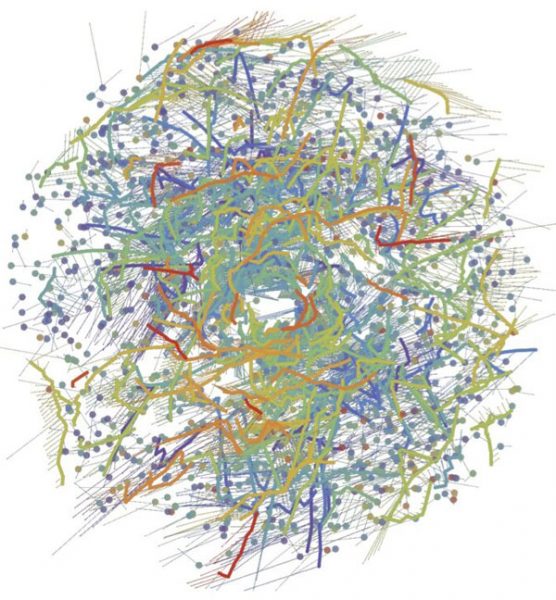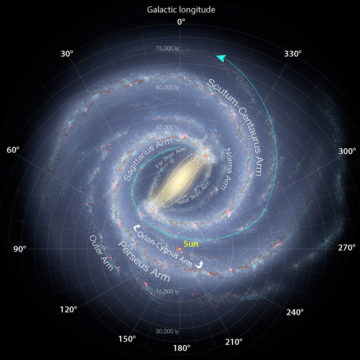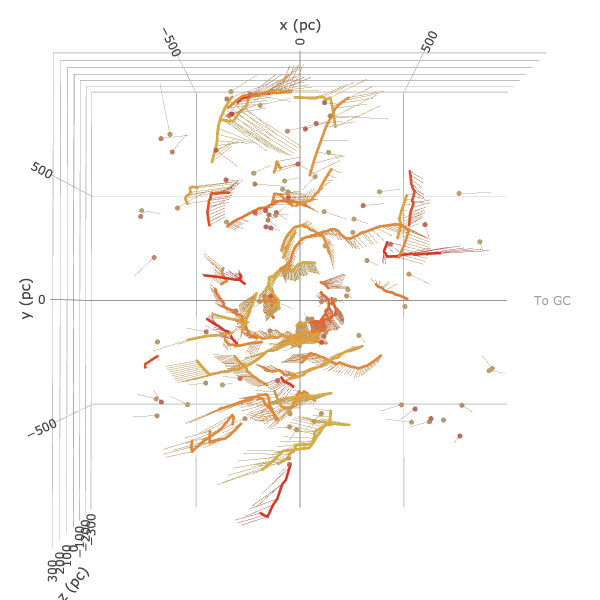Untangling Stellar Strings in the Milky Way – Sky & Telescope
Long-lived, string-shaped groups of stars align with the Milky Way’s spiral arms — and they may provide clues to what those arms looked like long ago.
Astronomers have identified thousands of stellar groups within 3,000 light-years of the Sun. But the 3D map they created resembles a tangle of yarn more than it does a field of stars.
That’s because hundreds of the groups they discovered appear to be filamentary, thread-like structures. These threads of stars may trace the evolution of the Milky Ways’ spiral arms, Marina Kounkel (Western Washington University) and colleagues explain in the August 23rd Astronomical Journal.

This diagram shows a face-on view of stellar groups – clusters (dots) and co-moving groups (thick lines) of stars – within 3,000 light-years of the Sun (located at the center of the image).
Courtesy of M. Kounkel & K. Covey (2019)
Machines Pull the Strings
Kounkel and her colleagues started with 20 million stars for which the European Space Agency’s Gaia satellite had measured positions on the sky and distances from Earth, as well as velocities toward or away from Earth. The researchers used a type of artificial intelligence called unsupervised machine learning to sort through the immense amount of data, determining whether and how these stars are clustered.
“Unsupervised machine learning” may sound like trouble, but all it means in this case is that a computer algorithm grouped stars without being told what the groups ought to look like. As a result, the algorithm was able to find groups of all kinds of shapes and sizes — including strings.
Most stars, it appears, are on their own — the algorithm only tagged 1.5% of the 20 million stars as belonging to a group. But of those stars moving through space together, roughly half belong to long, string-shaped groups. The other half divide themselves among more than 1,000 smaller and more spherical groups.
The stellar strings are on average 30 light-years across and 650 light-years long, a length that matches the typical size of a star-forming cloud. Kounkel says it’s likely that a single cloud makes a single string of stars.
What’s more, none of the strings has a central cluster, indicating that they didn’t start out as sphere-shaped groups that the Milky Way’s gravity pulled apart over time. Instead, Kounkel and her colleagues argue these groups been string-shaped from the get-go.
What’s My Age Again?
To explore the evolution of the string-like structures, astronomers need to know how old the stars are. But stars are reluctant to reveal their ages — burning balls of hydrogen gas don’t change much in appearance throughout lifetimes lasting billions of years.
Kounkel and her colleagues turned to machine learning a second time. This time, they trained a neural network on star clusters with known ages before setting it loose on the newly discovered groups. The astronomers then combined these results with more traditional methods to obtain more stellar ages.
You can explore an interactive, 3D map of the groups, separated by age, here.
(Note that the map divides stars by logarithmic age. A star marked as “7.0” in the map has an actual age of 107, or 10 million years.)
Spiral Echoes
The strings are surprisingly long-lived. “We generally thought young stars would leave their birth sites just a few million years after they form, completely losing ties with their original family,” Kounkel explains. “But it seems that stars can stay close to their siblings for as long as a few billion years.”

This detailed annotated artist’s impression shows the structure of the Milky Way. The Local Arm is labeled as the Orion-Cygnus Arm.
ESO
At the same time, the strings appear to trace something that’s surprisingly ephemeral: The Milky Way’s spiral arms. Though from afar spiral arms appear to be made of stars, they’re only forming stars — the stars themselves are passing through, the same way cars pass through traffic jams. When gas clouds hit the stop-and-go traffic, they become compressed, collapsing into groups of hundreds or thousands of stars.
The youngest strings — those younger than 100 million years old — together form a narrow structure that aligns with the Local Arm of the Milky Way, the spiral arm that houses the Sun. The strings themselves lie perpendicular to the Local Arm, though it’s still unclear why.

The Local Arm of the Milky Way is located near the vertical “x=0” line that crosses the plot. The youngest strings all fall along this line, though they generally line up perpendicular to it for reasons that remain unclear.
M. Kounkel et al. / Astronomical Journal
Kevin Luhman (Penn State), who was not involved in the study, says he’d expect the collection of strings to align with the Local Arm. “Because of the linear shape of the original arm and its clouds, the resulting stars will also have a linear, string-like configuration for a time,” he explains.
Older strings appear to align in ways that don’t relate to the Local Arm, but Kounkel and her colleagues argue they might mark other spiral arms that have since dissipated. Coauthor Kevin Covey (also at Western Washington University) notes, “Older strings are an important ‘fossil record’ of our galaxy’s spiral structure.”
The team plans further studies with Gaia data and comparisons with simulations to better understand how these stellar structures evolve.





